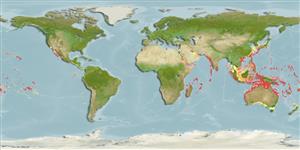Common names from other countries
Environment: milieu / climate zone / depth range / distribution range
экология
; пределы глубины 11 - 62 m (Ref. 3099). Tropical
Indo-Pacific.
Length at first maturity / Size / Вес / Возраст
Maturity: Lm ? range ? - ? cm Max length : 9 cm TL (female)
Minimum depth from Ref. 80410. Intertidal to subtidal (Ref. 106854). Inhabits sandy bays (Ref. 3533); shallow waters in sand flats, seagrass beds with coral rubble substrate (Ref. 80538) and also in reef flats or tidal flats under rock or boulders or inside rock crevices (Ref. 87055). Stomatopods are predators that require living prey (Ref. 833).
Life cycle and mating behavior
половая зрелость | размножение | нерест | икра | Fecundity | личинки
Some members of the order Stomatopoda pair for life and some come together only to mate. Males produce sperm ducts rather than spermatophores; females can brood a maximum of 50,000 eggs. Life cycle: Eggs hatch to a planktonic zoea which lasts for 3 months.
Основная ссылка
ссылки | координатор | соавторы
Ahyong, S.T. 2001. (Ref. 3099)
Статус Красного Списка МСОП (Ref. 130435)
Статус СИТЕС (Ref. 108899)
Not Evaluated
Not Evaluated
Угроза для людей
Harmless
Использование человеком
| FishSource |
инструменты
дополнительная информация
Возраст/РазмерыростЗависимость между длиной и массой телаЗависимость между длинамиморфологияличинкичисленность
ресурсы в Интернет
Estimates based on models
Preferred temperature
(Ref.
115969): 24.3 - 29, mean 27.8 (based on 912 cells).
